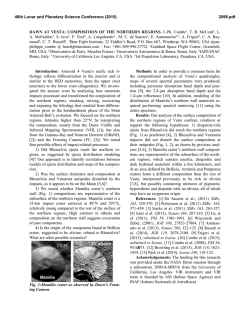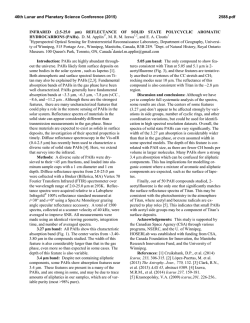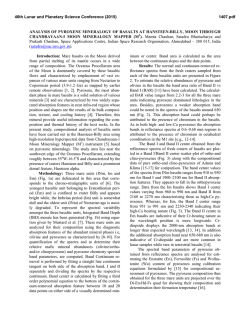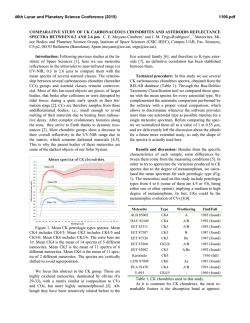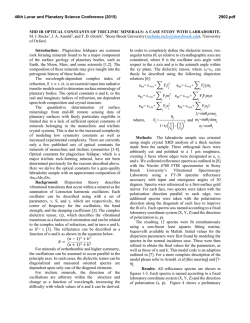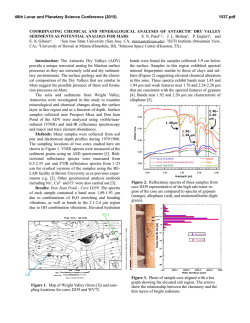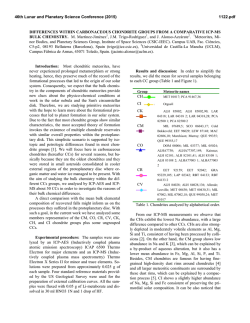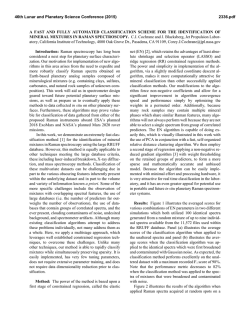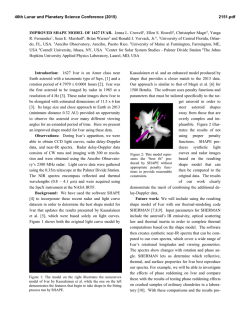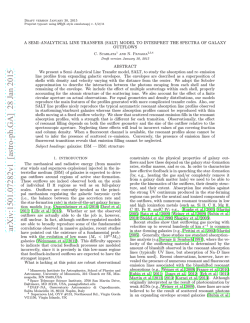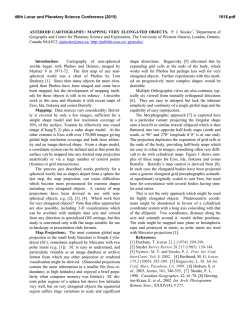
Dawn FC Band Parameters for the Detection of Fe
46th Lunar and Planetary Science Conference (2015) 2220.pdf DAWN FC BAND PARAMETERS FOR THE DETECTION OF FE-BEARING PHYLLOSILICATES ON CERES. T. Schäfer1, A. Nathues1, K. Mengel2, E. A. Cloutis3, M. Hoffmann1, M. R. M. Izawa4, M. Schäfer1, 1Max Planck Institute for Solar System Research, Justus-von-Liebig-Weg 3, 37077 Göttingen, [email protected], 3 Clausthal University of Technology, Clausthal-Zellerfeld, Germany, 3University of Winnipeg, Manitoba, Canada, 4 Royal Ontario Museum, Department of Natural History, Toronto, Canada. Introduction: Fe-bearing minerals of the serpentine group are believed to represent products of aqueous alteration of olivine and pyroxene rich ultramafic precursor materials in the system MgO-FeO-SiO2-H2O [1, 2]. These minerals may be present at the Ceres surface, either as an aqueous alteration product of possible olivine/orthopyroxene rich precursor material such as ordinary chondrites, or as a more "pristine" material such as CM carbonaceous chondrite meteorites. Laboratory spectra of CM as well as terrestrial serpentines show absorption features at about 0.7, 0.9 and 1.1 µm [3]. Those features have been assigned to Fe2+Fe3+ intervalence charge transfer (IVCT) of octahedrally coordinated Fe3+ (0.7 µm) and crystal field (CFT) absorptions of octahedrally coordinated Fe2+ (0.9 and 1.1 µm) by [4, 5]. These coordination states of iron are also present in spectra of terrestrial iron bearing phyllosilicates [6, 7, 5]. The Framing Camera (FC) onboard the Dawn spacecraft will arrive at (1) Ceres in March 2015. With the seven FC color filters we expect to be able to detect the 0.7 µm and 0.9 µm absorption bands of these materials by using the filters at 0.749 µm and 0.917 µm, as well as the adjacent filters. The parameter at 0.749 µm has already been applied to detect exogenic CM material on (4) Vesta [8]. As we expect a much more featureless spectral background on the Ceres surface from ground-based observations, not dominated by the pyroxene absorption band around 0.9 µm like previous Dawn FC data from Vesta, the accompanying absorption feature at FC filter wavelength 0.917 µm should be also detectable. The third absorption feature at 1.1 µm lies outside the FC wavelength range. Data & Method: We used laboratory spectra of Fe-bearing antigorite and chlorite from the USGS spectral library investigated by [6], a serpentinite (also containing magnesite) from RELAB published in [3], and a CM2 carbonaceous chondrite from RELAB verified by the Meteoritical Database of the Meteoritical Society. We deconvolved these spectra to FC band passes, resulting in reflectances for the seven color filter bands (0.438, 0.555, 0.653, 0.749, 0.829, 0.917, 0.965 µm) [9], and developed spectral parameters for recognizing the presence of absorption features in the 0.7 and 0.9 micron regions. We tested our parameters on the aforementioned samples as well as a variety of carbonaceous chondrite groups from RELAB verified by the Meteoritical Database and described in recent spectral studies by [10, 3, 11–15]. Results: We developed a combination of three FC color filter band parameters to detect the 0.7 µm IVCT absorption and the 0.9 µm CFT absorption of Fe2+- and Fe3+-bearing phyllosilicates. Figure 1 illustrates the spectra of Fe-bearing antigorite, chlorite and serpentinite along with the spectrum of a phyllosilicate-bearing CM2. The overlain thicker lines are the spectra deconvolved to FC bandpasses. The diagnostic absorption bands closely coincide with the FC filters centered at wavelengths of 0.749 µm and 0.917 µm as they sample the long wavelength side of these absorption features (Fig. 1). On this basis we defined the parameters BP 0.749 µm and BP 0.917 µm that measure the strength of the respective absorption band. In the case of an existing absorption feature the values for these parameters are > 1. An additional parameter BP 0.829 µm provides a verification for the existence of the two neighboring absorption bands by indicating values < 1, as the 0.829 µm band falls between the two absorption bands. The three parameters and the condition for coexisting 0.7 µm and 0.9 µm absorption bands are defined below, where Rλ is the reflectance at filter wavelength λ and BP λ is the band parameter at filter wavelength λ. The factors consider a weighting of the unequal spacing between center wavelengths of the FC filters. 0.749μ = 0.917μ = 0.55 ∙ 0.35 ∙ . + 0.45 ∙ . . + 0.65 ∙ . 0.829μ = 0.52 ∙ . . . . + 0.48 ∙ . Condition for coexisting 0.7 µm and 0.9 µm absorptions: BP 0.749 µm > 1 ˄ BP 0.917 µm > 1 ˄ BP 0.829 µm < 1 Among the carbonaceous chondrites these two spectral features are only present in CM spectra, as expected. Thirty two of the overall investigated 41 CM carbonaceous chondrites fulfill the condition for all three parameters. For the CI, CK, CV, CO, and CR carbona- 46th Lunar and Planetary Science Conference (2015) ceous chondrite groups, no spectrum meets the conditions indicating the presence of any absorption bands, consistent with their mineralogies and visual examination of their spectra as investigated by [10, 3, 11–15]. Discussion: The three band parameters are verified against an extensive suite of carbonaceous chondrite spectra. Both parameters that measure band strength - BP 0.749 µm and BP 0.917 µm - are strongest for the pure mineral samples antigorite and chlorite, both of which contain ferric and ferrous iron (Fig. 2). As the CM2 only shows weak absorption features these parameters are lowest for this sample. This could represent a realistic analogue for the Ceres surface as CMs are the most realistic extraterrestrial material mixture containing phyllosilicates and darkening agents which subdue not only the OH absorptions in phyllosilicates and CCs [16] but also weaken the 0.7 µm feature of serpentine [8]. It should be noted that our band parameters are primarily intended for the qualitative detection of the 0.7 µm IVCT and 0.9 µm CFT absorptions in the upcoming FC image data. A correlation to band depth, and ability to quantify Fe-phyllosilicate abundance, may be limited by the superposition of a continuum and the additional broad absorption between 0.6 and 1.8 µm, as well as the presence of additional phases (Fig. 1). However, these band parameters can serve as a rapid and sensitive tool for detecting the presence of mixed valence Fe-bearing phyllosilicates which, as mentioned, are most characteristic of CM2-type CCs. References: [1] Evans B. W. (2008) J. Petrol., 49 (10), 1873–1887. [2] Evans, B. W. et al. (2009) Am.Mineral. 94 (11-12), 1731–1734. [3] Cloutis, E. A. et al. (2011b) Icarus 216 (1), 309–346. [4] Clark, R. N. et al. (1990) JGR, 95, 12,653-12,680. [5] Burns, R. G. (2005): Mineralogical applications of crystal field theory. 2nd ed., 576 p., Cambridge University Press. [6] King T. V. V. & Clark, R. N. (1989) JGR, 94 (10),13,997–14,008. [7] Calvin, W. M. & King, T.V.V. (1997) Meteorit Planet. Sci. 32, 693–701. [8] Nathues A. et al. (2014) Icarus, 239, 222–237. [9] Sierks et al. (2011) Space Sci.Rev., 163, 263-327. [10] Cloutis, E. A. et al. (2011a) Icarus 212 (1), 180–209. [11] Cloutis, E. A. et al. (2012a) Icarus, 217 (1), 389–407. [12] Cloutis, E. A. et al. (2012b) Icarus, 220 (2), 466–486. [13] Cloutis, E. A. et al. (2012c) Icarus, 220 (2), 516– 617. [14] Cloutis, E. A. et al. (2012d) Icarus, 221 (1), 328–358. [15] Cloutis, E. A. et al. (2012e) Icarus, 221 (2), 911–924. [16] Johnson, T. V. & Fanale, F. P. (1973) JGR, 78 (35), 8507–8518. 2220.pdf Figure 1. Laboratory spectra of terrestrial Fe-bearing antigorite, chlorite, serpentinite and a CM2 carbonaceous chondrite. Thicker lines show spectra deconvolved to FC bandpasses. Figure 2. Strength of the band parameters in CM2, serpentinite, antigorite and clinochlore. Acknowledgements: We are thankful for the work at USGS spectral library and RELAB facility and also thank the numerous authors who provide their spectra there. Funding of the first author is given by IMPRS at Max Planck Institute for Solar System Research.
© Copyright 2024
